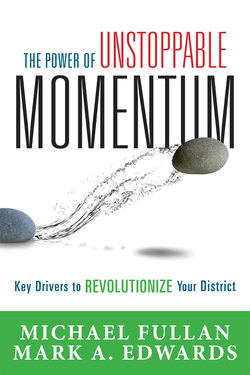Читать книгу The Power of Unstoppable Momentum - Michael Fullan - Страница 9
На сайте Литреса книга снята с продажи.
Оглавлениеchapter two
DEEP LEARNING
Achieving stratospheric success in implementing technology in education is like an iceberg. The technology is clearly visible, but below the surface is something much larger that really counts. This something is where we find deep learning, a melding of skills and attributes that range from critical thinking and problem solving to citizenship and creativity. The deep learning process also includes the necessary pedagogy transformation to develop these new competencies. In this chapter, we outline the effective deep learning programs in the Mooresville Graded School District, where Mark A. Edwards was superintendent.
Andy Hargreaves and his colleagues (2014) describe the lens through which to view a district’s success in Uplifting Leadership—successful systems learn from, but never imitate, other effective organizations. We explore how you can establish your district’s own cultural transformation, the driving factors that catalyze innovation, and the people and groups working to extend connections that advance knowledge across both district and country lines. We conclude with a threefold model for professional capital that sets up much of the rest of this book.
Mooresville Graded School District
Both Every Child, Every Day (Edwards, 2014) and Thank You for Your Leadership (Edwards, 2016) outline the MGSD transformational process. This district has approximately 6,200 students in seven schools and a technical education center affiliated with the high school. Free and reduced lunch eligibility has increased to about 40 percent of the student population since the economic downturn in 2008. The student population is 72 percent Caucasian, 18 percent African American, and 8 percent Hispanic.
In 2007, MGSD embarked on a digital conversion of all schools—from a paper-based to a digital world in which every student and teacher has access to a computer device and to anywhere, anytime Internet. This is the tip of the iceberg. In 2015, MGSD ranked 99th of 115 North Carolina districts in per-pupil funding from all sources (local, state, and federal). Despite this disadvantage, the district’s graduation rate jumped to 93 percent (second in the state) and its academic performance to 89 percent (third in the state) in 2011. The district has maintained this improvement. In fact, all academic and attendance performance indicators have increased steadily since 2008. For example, according to data from the North Carolina Department of Public Instruction (n.d.a, n.d.b), academic district performance increased from 73 to 90 percent between 2007 and 2015; graduation rates from 70 percent in 2007 to 90 percent in 2015; and so on. Table 2.1 and figure 2.1 illustrate the district’s stark improvement.
Table 2.1: North Carolina District Achievement, 2014–2015
| Rank | District | 2014–2015 Proficiency |
| 1 | Chapel Hill-Carrboro | 77 percent |
| 2 | Union | 72 percent |
| Polk | 72 percent | |
| 3 | Mooresville Graded | 71 percent |
Figure 2.1: Four-year cohort graduation rate at MGSD.
Based on the MGSD experience, we developed a set of guidelines to help districts move rapidly and soundly to stratospheric deep learning performance on a systemwide basis. The following eight guidelines reflect the elements of whole-system change (Fullan, 2010).
1. Moral imperative (high expectations for all students)
2. Culture of caring (caring for all with a push for efficacy)
3. Digital resources and infrastructure (support, ubiquity of access)
4. Evolutional capacity building (individual and team)
5. Instructional transformation (new pedagogy for student and teacher engagement)
6. Daily date with data (building an evidence-based culture)
7. Resource alignment (establishing priorities and repurposing resources accordingly)
8. All-in collaboration (everyone counts and is implicated)
These elements gain their power through their interaction with each other. A cookbook recipe or an organizational change model is impossible because the dynamics are often subtle and many issues are peculiar to a given culture. However, schools can do a much better job of getting at the key factors and their interactions. The following key factors played a major role in the MGSD results.
• Coalescing leaders at all levels around a shared vision (developing coordinated leadership at the school and district levels)
• Establishing leadership for high performance (adjusting to the push and pull of change)
• Creating a culture for collaborative work (with focus and specificity)
• Developing an evidenced-based culture (availability, transparency, precision of data for action)
• Establishing leadership development for all (informal and formal processes for leading and learning at all levels)
• Managing the tough stuff within a caring climate (being accountable internally at the district level and externally at the state or province level)
These six factors in concert framed the shift in culture at MGSD. Constant reflective dialogue in which staff routinely asked questions like “How is the work going?” and “What are we learning?” provided everyone with a shared feeling and purpose of their role in authoring the transformation story. By applying these guidelines and key factors in a way that addresses your district’s unique needs, you can begin the process of establishing a cultural transformation that achieves measurable results for your entire student body.
Cultural Transformation
A successful change process involves developing a culture where everyone models and expects visibility; practice and results are transparent; action is precise; problem solving is innovative, but disciplined; and everyone is engaged each day. At MGSD, everyone means students, parents, janitors, clerical staff, teachers, and administrators at all levels. One effective way of developing and reinforcing this kind of culture is to expect that everyone becomes a teacher for everyone else, inside and outside of the district. This is a win-win proposition that helps everyone get better as they develop “a shared understanding about the nature of the work” (Fullan & Quinn, 2016, p. 2).
